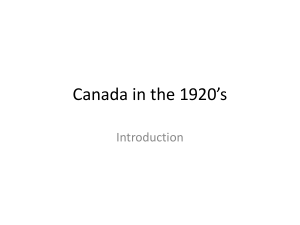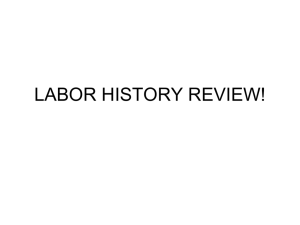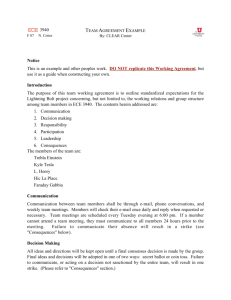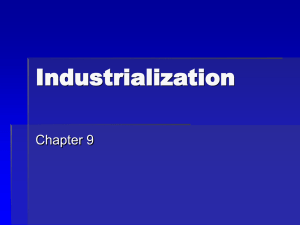Do Now
advertisement
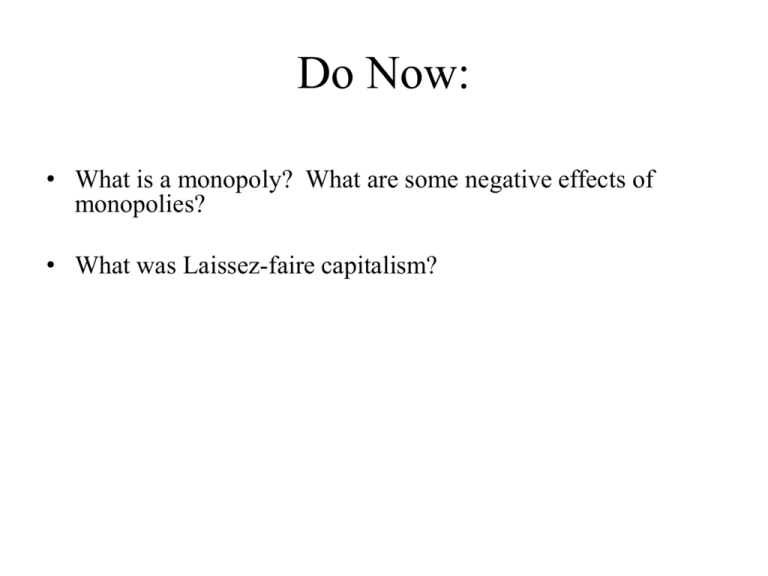
Do Now: • What is a monopoly? What are some negative effects of monopolies? • What was Laissez-faire capitalism? The Rise of Labor Unions The Need for Reform Grows Mr. Winchell APUSH Period 6 Faces of Lost Youth The Pictures of Lewis Hine http://www.historyplace.com/unitedstates/childlabor/ Other Images, by Jacob Riis The Changing American Labor Force “Galley Labor” Problems: • Working conditions: – Dangerous • Heavy machinery • Dangerous conditions in mines, construction etc. • Hot and unsanitary – Long hours, low wages, no job security, no worker’s benefits (example: healthcare, paid holidays, paid maternity leave). – Company towns • often workers had to live in homes provided by factory owners. • Homes were often more expensive to rent than outside housing • Homes were often in poor condition – Child labor, immigrant labor, and employment of women = lower wages Opposed unrestricted immigration Immigration = cheap labor Refused women and African-Americans as members Supported free compulsory education Remove child labor from the workforce Management vs. Labor “Tools” of Management “Tools” of Labor “scabs” boycotts P. R. campaign sympathy demonstrations Pinkertons lockout blacklisting yellow-dog contracts informational picketing closed shops court injunctions organized strikes open shop “wildcat” strikes • 1881-1900 – 24,000 strikes in the US • many blamed labor unrest on infiltration of socialists and anarchists After the Triangle Shirtwaist Factory Fire the International Ladies Garment Workers Union, was formed. Successes: Brought aid to families of victims of the fire Modern factory inspection system established Laws to regulate the labor of women, children and safety regulations established Triangle Shirtwaist Factory Clip Knights of Labor – Founder: Uriah Stevens and Terrance V. Powderly – What they wanted: 8 hour workday, higher wages – Who could join: skilled and unskilled workers – Methods they used: strikes – Declined by 1886 Haymarket Square Riot - 1886 • Knights of Labor led a strike for 8 hour work day • A bomb was thrown during the protest meeting held by striker and the police were called in. • Impact: – Knights of Labor are identified as anarchists and associated with violence – American public turned against them, and against labor unions in general The American Federation of Labor 1881 • Founder: Samuel Gompers • What they wanted: 8 hour work day, improved working conditions, higher wages • Who could joined: different skilled craft workers • Methods used: Strikes and Boycotts • Successes: – won the closed shop (where factories could only hire union workers) – Abolished yellow-dog contracts (companies had required workers to sign contracts promising NOT to join a union) Homestead Strike - 1892 • Carnegie Steel Company threatened to cut wages • Workers picketed and management called in the Pinkerton Guards. Violence erupted. • Strike lasted 9 months. President of Carnegie Steel shot in the neck. • Public opinion turned against on the protesters. • Workers returned to work on the company’s terms. American Railway Union • Founder Eugene V. Debs • What they wanted: 8 hour work day, improved working conditions, higher wages • Who could join: skilled and unskilled workers • Won a major striker for better wages but lost another major strike and ended up struggling for members. Pullman Strike 1894 • Pullman Palace (Rail) Car Company had cut wages • Strike spread and brought railroad traffic west of Chicago to a standstill • Strikers received help from Eugene V. Debs and American Railway Union • President Cleveland sent troops and Supreme Court obtained a court injunction to stop the strike. – Why? Court said the federal government may intercede when interstate commerce is affected. Mother Jones: “The Miner’s Angel” Mary Harris. Organizer for the United Mine Workers. Founded the Social Democratic Party in 1898. One of the founding members of the I. W. W. in 1905. Labor Union Membership

